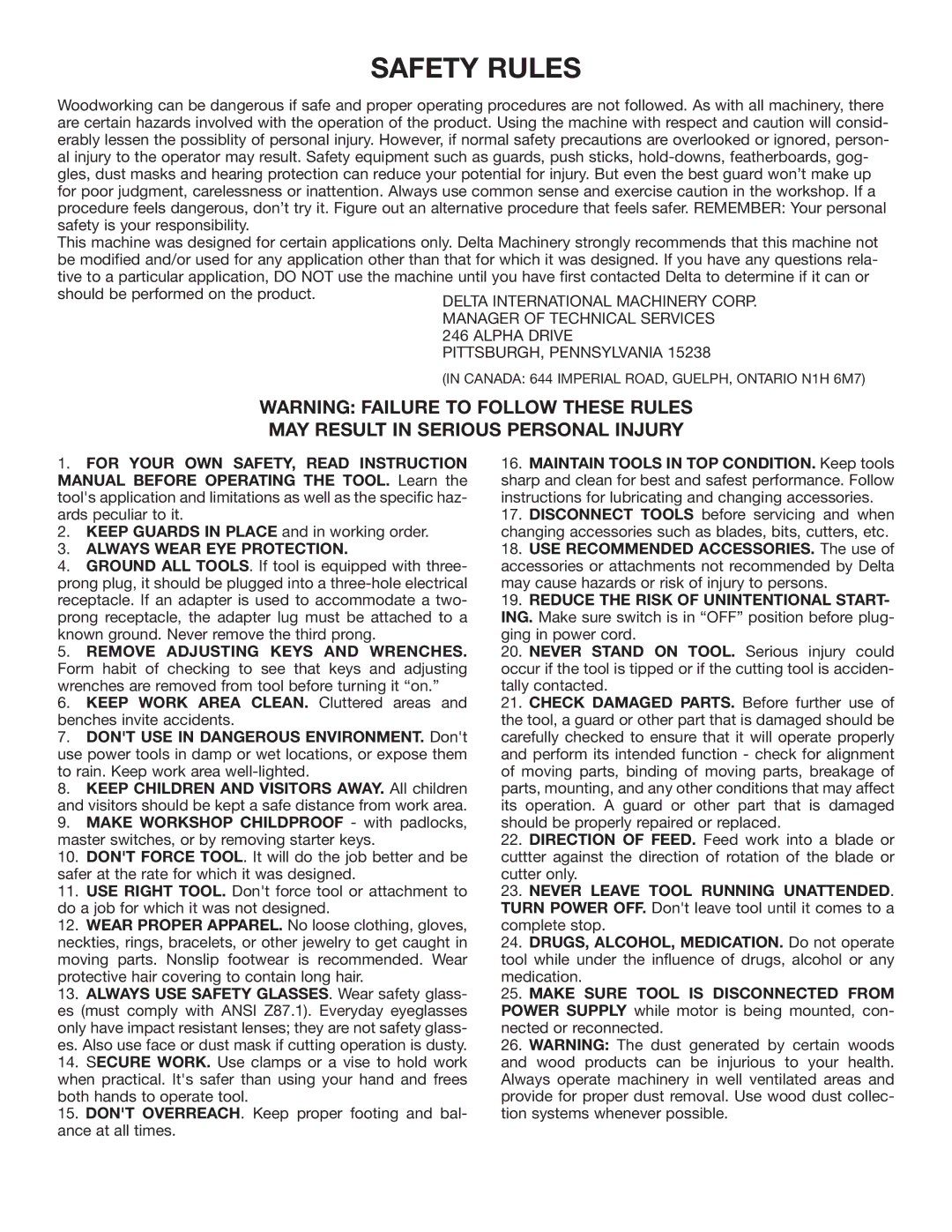1.FOR YOUR OWN SAFETY, READ INSTRUCTION MANUAL BEFORE OPERATING THE TOOL. Learn the tool's application and limitations as well as the specific haz- ards peculiar to it.
2.KEEP GUARDS IN PLACE and in working order.
3.ALWAYS WEAR EYE PROTECTION.
4.GROUND ALL TOOLS. If tool is equipped with three- prong plug, it should be plugged into a
5.REMOVE ADJUSTING KEYS AND WRENCHES. Form habit of checking to see that keys and adjusting wrenches are removed from tool before turning it “on.”
6.KEEP WORK AREA CLEAN. Cluttered areas and benches invite accidents.
7.DON'T USE IN DANGEROUS ENVIRONMENT. Don't use power tools in damp or wet locations, or expose them to rain. Keep work area
8.KEEP CHILDREN AND VISITORS AWAY. All children and visitors should be kept a safe distance from work area.
9.MAKE WORKSHOP CHILDPROOF - with padlocks, master switches, or by removing starter keys.
10.DON'T FORCE TOOL. It will do the job better and be safer at the rate for which it was designed.
11.USE RIGHT TOOL. Don't force tool or attachment to do a job for which it was not designed.
12.WEAR PROPER APPAREL. No loose clothing, gloves, neckties, rings, bracelets, or other jewelry to get caught in moving parts. Nonslip footwear is recommended. Wear protective hair covering to contain long hair.
13.ALWAYS USE SAFETY GLASSES. Wear safety glass- es (must comply with ANSI Z87.1). Everyday eyeglasses only have impact resistant lenses; they are not safety glass- es. Also use face or dust mask if cutting operation is dusty.
14.SECURE WORK. Use clamps or a vise to hold work when practical. It's safer than using your hand and frees both hands to operate tool.
15.DON'T OVERREACH. Keep proper footing and bal- ance at all times.
16.MAINTAIN TOOLS IN TOP CONDITION. Keep tools sharp and clean for best and safest performance. Follow instructions for lubricating and changing accessories.
17.DISCONNECT TOOLS before servicing and when changing accessories such as blades, bits, cutters, etc.
18.USE RECOMMENDED ACCESSORIES. The use of accessories or attachments not recommended by Delta may cause hazards or risk of injury to persons.
19.REDUCE THE RISK OF UNINTENTIONAL START- ING. Make sure switch is in “OFF” position before plug- ging in power cord.
20.NEVER STAND ON TOOL. Serious injury could occur if the tool is tipped or if the cutting tool is acciden- tally contacted.
21.CHECK DAMAGED PARTS. Before further use of the tool, a guard or other part that is damaged should be carefully checked to ensure that it will operate properly and perform its intended function - check for alignment of moving parts, binding of moving parts, breakage of parts, mounting, and any other conditions that may affect its operation. A guard or other part that is damaged should be properly repaired or replaced.
22.DIRECTION OF FEED. Feed work into a blade or cuttter against the direction of rotation of the blade or cutter only.
23.NEVER LEAVE TOOL RUNNING UNATTENDED. TURN POWER OFF. Don't leave tool until it comes to a complete stop.
24.DRUGS, ALCOHOL, MEDICATION. Do not operate tool while under the influence of drugs, alcohol or any medication.
25.MAKE SURE TOOL IS DISCONNECTED FROM POWER SUPPLY while motor is being mounted, con- nected or reconnected.
26.WARNING: The dust generated by certain woods and wood products can be injurious to your health. Always operate machinery in well ventilated areas and provide for proper dust removal. Use wood dust collec- tion systems whenever possible.
